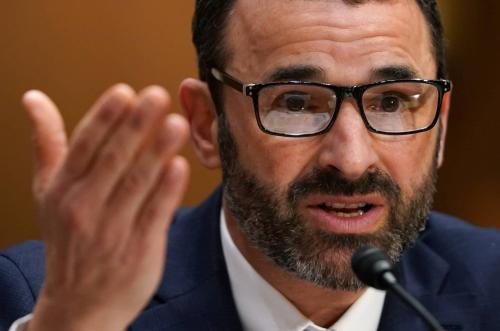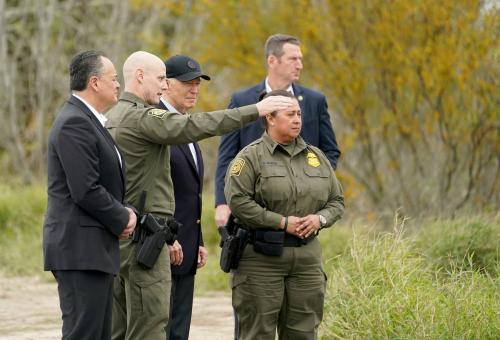Immigration attempts at the southwest border of the United States are quickly becoming one of the most important issues, if not the most important issue, for 2024. Recent articles in these pages by my colleague Bill Galston have discussed the tortured history of immigration reform and the legal ambiguity surrounding what a president can and can’t do to control the border. And President Biden, following the failure of a compromise immigration reform bill that went further than any Democrats have gone, is mulling a plan to tighten up, and perhaps close, the border.
Regardless of what actions take place in the short term, whether by statute or executive action, the border crisis will be with us for a long time. There are four reasons for this.
- First, the numbers of people trying to come to the United States have skyrocketed as migrants from all over the world, not just Mexico, try to come here.
- Second, it is more difficult to hire border patrol agents than perhaps any other law enforcement position in the federal government.
- Third, the situation at the border poses the classic issue of surge management.
- And finally, chronic underfunding has created an enormous backlog in the immigration courts.
Let’s take these one at a time.
People attempting to enter the United States at the southern border are no longer just from Mexico
The 21st century has seen a huge increase in the number of people wanting to come to the United States. While historically most immigration has been from Mexico, recent trends have shown a much broader range of countries. According to the Migration Policy Institute: “Mexicans are the largest group of U.S. immigrants, comprising 24% of the total immigrant population in 2021, which is a decline from 30% in 2000. India and China (including Hong Kong and Macao but not Taiwan) were the next two largest sending countries, accounting for approximately six percent and five percent, respectively, of the overall foreign-born population. Other top countries of origin include the Philippines (four percent); El Salvador, Vietnam, Cuba, and the Dominican Republic (each three percent); and Guatemala and Korea (each two percent).”
The implications of this globalization of migration are enormous. While the United States could absorb and even thrive on normal levels of migration, it cannot accommodate millions of people fleeing poverty. The most recent global poverty headcount from the World Bank is 659 million — about twice the population of the United States.
It is very hard to hire border patrol agents
The compromise bill that came out of the Senate provides $584,116,000 designated for the hiring of CBP personnel and $139,000,000 designated for overtime costs for the U.S. Border Patrol. This should allow them to hire 1,500 more border patrol agents. But you can’t hire border patrol agents overnight. All border patrol agents must undergo extensive background checks and for good reason. The leader of a terrorist cell or the leader of a drug cartel would like nothing better than to have a few of their own people manning the border! But background checks take months, sometimes years. In addition to the security background checks, border patrol agents must pass demanding physical tests.
Second, Customs and Border Patrol must compete with other federal law enforcement organizations to fill their positions. The southwestern border jobs are in geographically remote places, consisting of miles and miles of isolated desserts and small towns. Not surprisingly, people who might have the appropriate law enforcement or military background to do this kind of work may not want to move there and bring their families down to the border. To counter this, CBP now offers a $10,000 bonus for people willing to live in remote locations. The difficulties in hiring led former INS commissioner Doris Meissner to estimate that approximately 27 candidates are needed to hire one Border Patrol officer.
Another reason it takes so long to hire agents is that individuals who apply to Border Patrol agent positions must take a polygraph (lie detector) test, but data shows that 65% of applicants fail the test, a rate that is far higher than in other federal law enforcement agencies. In an effort to expedite hiring, the bill passed in the Senate would give CBP a three-year waiver from conducting polygraph tests for any applicant who received one in the previous 10 years for any other law enforcement agency — which is a step in the right direction.1 Another attempt to hire more quickly has been a recent offer by the government to pay $20,000 bonuses for new Border Patrol agents as an incentive to new hires.
Daunting as they are, the hiring problems at the border are likely to get worse. The Inspector General of the Department of Homeland Security is warning of an upcoming surge in retirements in the next few years — which will only add to the manpower problems.
Because CBP has struggled for years to fill Border Patrol positions, lawmakers have raised concerns about how practical the proposed hiring surges are, especially considering the previous administration’s challenges. The last time this was tried was in President Trump’s first year in office. Then, as now, one of Trump’s first goals was to try and dramatically reduce immigration — especially at the southwest border. He asked for and got authority to expand the size of the U.S. Border Patrol by hiring 7,500 new agents. Knowing that this ramp up would be difficult to do with their current workforce, in 2017, CBP awarded a $297 million contract to Accenture to help carry out the hiring. The effort was a bust. The contract was terminated after the company had only completed processing 58 applicants. And out of those 58 applicants, only 22 had made it onto the payroll about a year after the company was hired.
The federal government has always been slower to hire than the private sector has been — for reasons good and bad and too lengthy to go into here. Add in the necessity of extensive background checks for many federal government jobs and the process gets even longer. In fiscal year 2015, it took an average of 282 days to hire a Border Patrol agent — down from 598 days in 2011. In 2019, the average time to hire a Border Patrol agent was still 300 days, so the agency implemented the Fast Track Hiring process with a goal of reducing the time to 120 days or less.
The problem of surge management
Staffing the border presents a problem that is common to many large organizations, public and private: surge management. In the private sector, this often refers to issues in the supply chain. Applied to DHS, surge management means having to maintain a workforce to deal with a situation that can fluctuate wildly. To illustrate the surge management problems of DHS, let’s look at the following chart.
In October of fiscal year 2021, the number of land border encounters at the southwest border was 71,929.2 A year later, it had more than doubled to 164,837. By October of fiscal year 2023, it had more than tripled to 240,942. And two months later, in December of fiscal year 2024, the numbers had quadrupled to 301,983.
The surge of migrants at the border is a classic problem in surge management. While the number of migrants quadrupled, the number of border agents did not — as the chart below illustrates. And given all the factors listed above, it would have been very difficult to hire four times as many agents in that short a period.
There are many reasons for the surge from 2023 to 2024. For instance, the Biden administration lifted the restrictions put in place during the COVID-19 pandemic, which severely limited the number of refugees. The second is that after Trump’s harsh rhetoric and Biden’s more sympathetic tone, many people in other countries perceived that under Biden it would be easier to get into the United States. Third is ongoing economic and social strife in many countries around the world. For example, during this time, the Venezuelan economy totally collapsed, and as a result, the number of Venezuelan immigrants more than doubled between 2010 and 2021.
The Border Patrol agencies have tried to deal with the surge by moving agents from other borders to the southern border and by mandating overtime. But this is not a long-term solution. And, as any manager knows, it can backfire by contributing to attrition in the organization.
The immigration court backlog
The next enormous hurdle is doing something about the backlog in the immigration courts. As of January 2024, there was a backlog of 3,363,667. cases in the immigration courts. The following chart from Syracuse University shows the dramatic rise in cases in recent years.
The result of this backlog is that it can take months or years from the time an immigrant is given a Notice to Appear (NTA) to the time they get a hearing before a judge. In California, this can take between two and three years. Meanwhile, the number of cases closed lags far behind the number of cases received.
There are currently 682 immigration judges on the bench. Given the enormous increase in migrants, the new average number of pending cases per judge is 4,500 — an impossible number for one human being to process. According to scholars at Syracuse University, in the last fiscal year, each judge closed an average of 975 cases, significantly hirer than the average number of cases closed in the Obama years but still not close to what is needed. And a study from the Congressional Research Service shows that the percentage of case completions has declined steadily since fiscal year 2008 — reaching a new low in FY 2022. Although hiring of new judges increased during the Biden years, it is still far below what is needed.
It would take a major increase in judge hiring to manage or reduce the backlog of cases over the next decade. The Congressional Research Service study referred to above shows that it would take doubling the current judge workforce to end the backlog by 2032. This would take a lot more funds and may prove difficult given the experience criteria for the role. Trump-era appointments to immigration judgeships had less immigration law experience, which is one way to promote fast hiring (with potential obvious consequences for quality of justice). Additionally, given recent legislative focus on delegating asylum cases to border agents as opposed to putting them on a judge’s docket, expansive judge hiring may not be prioritized.
The solution: Close the border temporarily, staff for surges, and get rid of the backlog
The Biden Administration is currently weighing executive actions they could take to effectively close down the border by invoking law 212(f). This needs to be done to give the government breathing room to deal with the large numbers that are overwhelming them. Earlier, the Biden administration created a regulation limiting migrants’ rights to asylum if they haven’t first sought protection in a third country. But given the crush at the border and the overworked personnel, they can’t even properly screen and thus implement the decisions they’ve already made.
The next thing the administration has to do is train and recruit a cadre of immigration judges which can work through the backlog. Incentives should be considered, such as paying law school debts to get people to sign on to be trained and recruited to work the backlog — even if for only a short period of time. This sort of program exists in the medical field where the government pays a portion of medical school loans in return for agreeing to work on Native American reservations.
Finally, the border agencies have to have a surge plan in effect. As we have seen historically, migration waxes and wanes. Some countries fall into crisis and people try to leave; other countries get their act together and migration decreases. The government needs to be ready for either possibility. It makes no sense to staff up the border for millions of migrants if the flow is in the thousands.
The best model we have in the U.S. government for surge management is in the military. They have two basic reserve components, the National Guard and the reserve forces of the various military services. The guard is subordinate to the states (except when the president federalizes it), while the reserve forces are completely part of the defense department. Both organizations are part time, but they provide invaluable assistance and capacity to the regular military in combat in times of need. A similar model could be adopted for the border. It would make sense for the Border Patrol or perhaps DHS to create a reserve component consisting of both Border Patrol agents and judges on standby — in order to deal with times when (like today) the situation at the border overwhelms the existing personnel.
But none of this can be implemented in the midst of the crisis taking place today. There are many people out there with legitimate claims to be in the United States. Their cases should be settled, and those who don’t qualify should be sent home. Biden should close down the border temporarily so that those who are already here can be fairly evaluated. Some will meet the criteria and many more will be sent home.
-
Footnotes
- The requirement for polygraph tests for border agents was instituted in 2010.
- Fiscal years in the federal government run from October 1 to September 30, thus October of fiscal year 2021 is October 2020.








Commentary
Fixing the border: Four reasons the immigration crisis isn’t going away
February 29, 2024